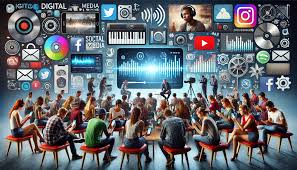Entertainment has always been a crucial aspect of human culture, offering an escape from daily life, a medium for storytelling, and a platform for artistic expression. Over the centuries, entertainment has evolved significantly, and the shift from traditional media to digital platforms marks one of the most transformative changes in recent decades. This article will explore how entertainment has changed over time, from its early forms to the rise of digital technologies and streaming platforms that are now shaping the entertainment landscape.
1. The Rise of Traditional Media: Radio, Television, and Film
The 20th century was defined by the rise of traditional media, with radio, television, and cinema emerging as the dominant forms of entertainment. These technologies brought entertainment directly into people’s homes, offering an accessible way to enjoy music, stories, and news.
Radio: The Birth of Mass Entertainment
The early 20th century saw the widespread introduction of radio, a groundbreaking medium that connected people with entertainment, news, and music broadcasts. Radio was one of the first mass communication tools, and it allowed families to tune in to their favorite shows and listen to live performances, creating a shared experience on a national scale.
By the 1930s and 1940s, radio had become a staple in every home, and shows such as The Shadow, Orson Welles’ War of the Worlds, and The Lone Ranger gained massive popularity. Radio was an integral part of the home entertainment culture and set the stage for future developments in media.
Television: A Visual Revolution
The advent of television in the mid-20th century revolutionized entertainment. Television brought visual storytelling directly into living rooms, changing the way people consumed media. With the rise of shows like I Love Lucy, The Ed Sullivan Show, and The Twilight Zone, TV quickly became a dominant form of entertainment.
Television also brought news broadcasts and live events like sports and political debates into homes, cementing its role as an essential tool for information and entertainment. The 1960s and 1970s, particularly, marked the golden age of television, with groundbreaking series like MAS*H and All in the Family, which often addressed social issues and reflected the times in which they aired.
Film: A Cultural Pillar
Film, as one of the most immersive forms of entertainment, has a long history that began in the late 19th century. The silent film era gave way to the talkies in the late 1920s, leading to Hollywood becoming the center of global film production. Major studios like MGM, Paramount, and Universal produced iconic films that were shown in theaters across the world, creating shared cultural experiences.
The rise of blockbuster films in the late 20th century, including classics like Star Wars, Jaws, and Jurassic Park, established the commercial appeal of movies. Cinemas became temples of entertainment, drawing millions of people to experience films on the big screen.
The home video revolution in the 1980s, with the advent of VHS tapes and, later, DVDs, allowed people to enjoy films in their own homes, further cementing the importance of film in popular culture.
2. The Digital Revolution: From CDs to Streaming Services
The late 20th and early 21st centuries saw a dramatic shift in entertainment, powered by digital technologies. These changes not only affected how content was consumed but also fundamentally transformed the entertainment industry as a whole.
The Rise of the Internet: A New Frontier for Entertainment
The internet became the driving force behind the evolution of entertainment. With the introduction of websites and platforms like YouTube in 2005, the ability to share and access content became more democratized. People no longer had to rely on traditional media outlets like radio or TV; instead, they could create and consume content at their own convenience.
Platforms like Napster and LimeWire allowed users to share and download music illegally, which led to the rise of digital music platforms. The MP3 format made it easier to store and share music, leading to the decline of CD sales and the rise of streaming services.
Streaming Services: The Shift from Physical to Digital
The most significant transformation in the entertainment industry came with the rise of streaming services. The success of Netflix, initially a DVD rental service, and the launch of its streaming platform in 2007 changed the way people accessed movies and TV shows. Netflix’s model was revolutionary in its convenience: users could watch movies and TV shows instantly, without the need for physical media.
Streaming platforms such as Spotify, Apple Music, and Amazon Prime Video followed suit, offering music, TV, and films on-demand, making entertainment more accessible and flexible than ever before. With the ability to watch content anytime, anywhere, and on various devices, the traditional model of syndicated television and cable subscriptions began to crumble.
User-Generated Content and Social Media
Social media platforms like Instagram, TikTok, and Twitter have become major sources of entertainment and self-expression, where content is often created and shared by users themselves. TikTok, in particular, has gained a reputation for fostering viral trends and creating new forms of digital entertainment, such as short-form videos and challenges.
The rise of influencers—individuals who create content and build large online followings—has created new career opportunities and transformed the landscape of entertainment marketing. Brands now rely on social media stars to promote products, while influencers turn their social media presence into lucrative businesses.
3. The Impact of On-Demand Content: The Decline of Traditional Broadcasting
One of the most significant shifts in entertainment has been the decline of traditional broadcasting. In the past, people had to schedule their lives around television broadcasts and radio shows. Now, thanks to streaming platforms and on-demand content, people can watch or listen to entertainment whenever they want.
Cable Television vs. Streaming Platforms
The rise of streaming services like Netflix, Hulu, Amazon Prime, and Disney+ has eroded the dominance of cable television. People are now opting for cord-cutting, abandoning traditional cable TV subscriptions in favor of more affordable, customizable streaming options.
Streaming services offer users a vast library of content across different genres, often with the ability to binge-watch entire seasons of TV shows. The personalization of content recommendations based on viewing history also enhances the user experience, ensuring that subscribers are always discovering new content tailored to their tastes.
Gaming: Interactive Entertainment
Video games have evolved from simple pixelated graphics to highly immersive experiences with breathtaking visuals and complex narratives. The gaming industry is now a massive global enterprise, offering a form of entertainment that is interactive and social.
With the growth of online multiplayer games like Fortnite, Minecraft, and League of Legends, gaming has become a social activity that brings people together from all over the world. The integration of streaming platforms like Twitch has allowed gamers to broadcast their gameplay live, creating a new form of entertainment for both players and spectators.
The advent of virtual reality (VR) and augmented reality (AR) is further revolutionizing the gaming world, providing users with more immersive, interactive experiences.
4. The Future of Entertainment: Emerging Technologies
Looking ahead, the future of entertainment will be shaped by cutting-edge technologies that promise to further transform how content is created, consumed, and shared. Here are a few emerging technologies that could define the next era of entertainment:
Virtual Reality and Augmented Reality
Virtual reality (VR) and augmented reality (AR) are already making waves in the gaming and entertainment industries. VR allows users to immerse themselves in a completely digital world, while AR overlays digital content onto the real world. Both technologies have the potential to transform gaming, live events, and even cinematic experiences, offering more interactive and immersive entertainment.
Artificial Intelligence in Content Creation
AI is becoming increasingly influential in the creation of entertainment content. AI tools can now generate music, write scripts, and even assist in the creation of visual effects for films. The use of deep learning algorithms allows for automated editing, sound mixing, and scene generation, which could revolutionize the filmmaking process.
Blockchain and NFTs in Entertainment
Blockchain technology is making its way into the entertainment industry, particularly with the rise of non-fungible tokens (NFTs). NFTs are digital assets that represent ownership or authenticity of a specific item, often related to art, music, or video. These tokens allow creators to monetize their work in new ways and offer consumers a direct way to invest in digital content.
Conclusion: The Ever-Evolving Entertainment Landscape
From the days of radio and cinema to the rise of streaming platforms and user-generated content, entertainment has evolved significantly over the years. Digital platforms, social media, and new technologies have redefined how we consume and create entertainment, making it more accessible and interactive than ever before.
As the entertainment industry continues to evolve, the lines between traditional media and digital platforms will blur even further. Emerging technologies like VR, AR, and AI will continue to shape the future of entertainment, offering new ways for consumers to engage with content. While we can’t predict the future with certainty, it is clear that the evolution of entertainment will continue to surprise, challenge, and inspire us for years to come.
Key Takeaways
- Traditional Media: Radio, TV, and cinema once dominated entertainment, creating shared experiences in people’s homes.
- Digital Revolution: The internet and streaming platforms have shifted entertainment consumption to on-demand and mobile access.
- Social Media: Platforms like TikTok, Instagram, and YouTube have created new forms of entertainment and self-expression.
- Emerging Technologies: VR, AR, AI, and blockchain are poised to further disrupt the entertainment industry, offering more immersive and interactive experiences.
- Future Outlook: The future of entertainment will be shaped by new technologies that continue to change how we engage with content.

